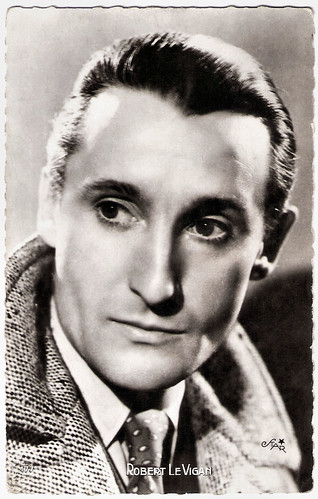
French postcard by Editions P.I., Paris, no. 177. Photo: Star.
Infused with poetic realism
Robert Le Vigan was born Robert-Charles-Alexandre Coquillaud in Paris, in 1900. His father was a veterinary. Robert was interested very early in the dramatic art and entered the Conservatoire de Paris (Academy of Paris). He won the second prize for comedy in his first year, but left the academy, when he learned that he would never obtain the first prize because of his military engagement.
He decided to find employment in variety and played minor parts to pay for acting lessons. In 1920, he becomes Robert Le Vigan, but during his career he was also credited as R. Le Vigan, Robert Levigan, and Le Vigan, and he was called ‘Vigue’ by his friend, the author Louis-Ferdinand Celine.
He interpreted Molière and Jean-François Regnard in Belgium, and later played Molière and George Bernard Shaw in the stage companies of Gaston Baty and Louis Jouvet. In 1927, he appeared with Arletty in sketches.
Director Julien Duvivier spotted him on stage and engaged him for his film Les Cinq Gentlemen maudits/The Five Accursed Gentlemen (Julien Duvivier, 1931) starring Harry Baur and René Lefèvre. In the following decade, Le Vigan would often work again with Duvivier, such as at the drama La Bandera/Escape from Yesterday (Julien Duvivier, 1935) with Annabella and Jean Gabin, and La charrette fantôme/The Phantom Wagon (Julien Duvivier, 1939) with Pierre Fresnay and Louis Jouvet. Like Duvivier's other works of the period, these films are infused with poetic realism.
In 1933, Le Vigan co-starred in the French-German science fiction film Le tunnel/The Tunnel (Kurt Bernhardt, 1933) with Jean Gabin and Madeleine Renaud. It told the story of a construction of a vast tunnel under the Atlantic Ocean connecting Europe and America. It was the French language version of the German film Der Tunnel, with a different cast and some changes to the plot. Such Multiple-language versions were common in the 1930s following the introduction of sound, and before the practice of dubbing had come to dominate international releases. Germany and France made a significant number of films together during the decade.
The next year, he appeared in the historical drama Madame Bovary (Jean Renoir, 1934), adapted from Gustave Flaubert's 1857 novel Madame Bovary. The film starred Valentine Tessier and Pierre Renoir, son of painter Claude Renoir and the older brother of the director.
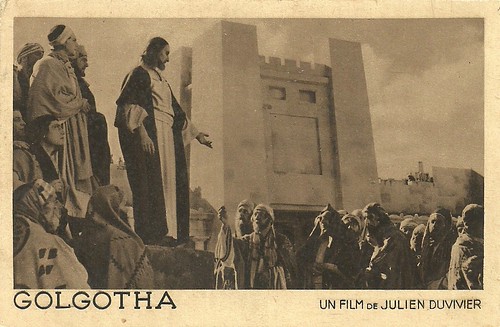
French postcard. Photo: publicity still for Golgotha (1935) with Robert Le Vigan as Jesus Christ.
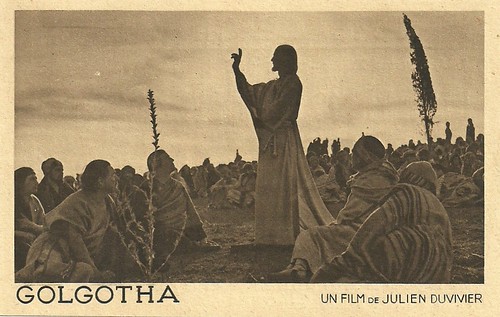
French postcard. Photo: publicity still for Golgotha (1935) with Robert Le Vigan as Jesus Christ.
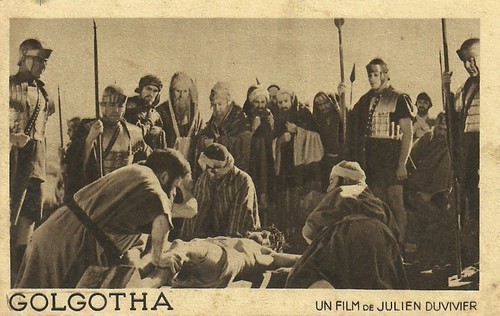
French postcard. Photo: publicity still for Golgotha (1935) with Robert Le Vigan as Jesus Christ.
Jesus Christ
A highlight in Robert Le Vigan's career was his role as Jesus Christ in Golgotha (Julien Duvivier, 1935), a French film about the death of Jesus Christ, released in English-speaking countries as Behold the Man. The film co-stars Harry Baur as Herod, and Jean Gabin as Pontius Pilate.
Le Vigan's performance marks the first direct portrayal of Christ in a sound film. For the most part, Jesus is shown from a respectful distance as was later also the case in Quo Vadis (Mervyn Leroy, 1951), The Robe (Henry Koster, 1953) and Ben-Hur (William Wyler, 1959), but there are also a few closer shots and even close-ups. The British Board of Film Censors did not allow British eyes to see the film, but the film did play throughout Europe and in the US. The American National Board of Review named the film the sixth best foreign film of 1937. This role earned him many praises and established Le Vigan as a sought-after character player.
The next year, he played an alcoholic actor in the drama Les Bas-fonds/The Lower Depths (Jean Renoir, 1936), based on a play of the same title by Maxim Gorky. A glimpse into the lives of several people living at the bottom of the social heap, focuses on a petty criminal (Jean Gabin), the woman he despises (Suzy Prim), and a bankrupt newcomer (Louis Jouvet) to the slum where the story is set. The film, a highlight of the poetic realism in the French cinema, received the first Louis Delluc Prize in 1937.
Le Vigan also worked with director Marcel L’Herbier at the drama La citadelle du silence/The Citadel of Silence (Marcel L'Herbier, 1937) starring Annabella, and with Marcel Pagnol at the drama Regain/Harvest (Marcel Pagnol, 1937), starring Fernandel.
Le Vigan also played a supporting character in another classic of poetic realism, Le Quai des brumes/Port of Shadows (Marcel Carné, 1938) with Jean Gabin, Michel Simon and Michèle Morgan. The film was the 1939 winner of France's top cinematic prize, the Prix Louis-Delluc. He also acted with Fernand Gravey, Michel Simon and Corinne Luchaire in the drama Le Dernier tournant/The Last Turning (Pierre Chenal, 1939), based on novel The Postman Always Rings Twice by James M. Cain, and the French musical Louise (Abel Gance, 1939) with Grace Moore.
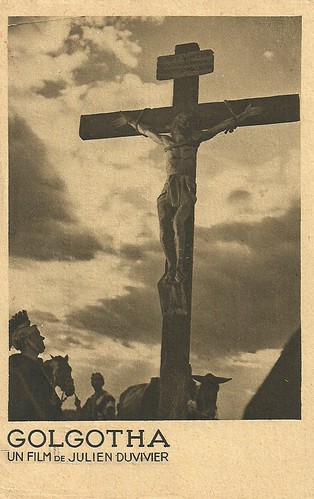
French postcard. Photo: publicity still for Golgotha (1935) with Robert Le Vigan as Jesus Christ. The verso of this card promotes the screening of this film at the Omnia Pathé in Paris between 18 and 24 October 1935.
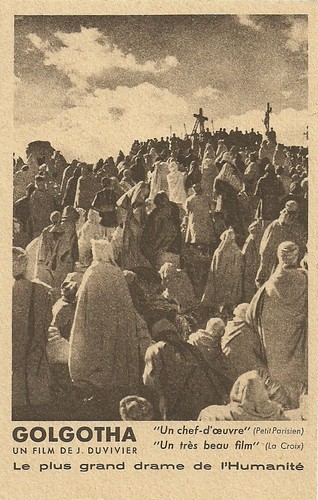
French postcard. Photo: publicity still for Golgotha (1935) with Robert Le Vigan as Jesus Christ.
Collaborator with the Nazis
In the Encyclopedia of European Cinema, Ginette Vincendeau calls Robert Le Vigan "a brilliant, extravagant actor, (...) specialised in louche, menacing or diabolical characters". During the occupation of France, the actor himself was a collaborator with the Nazis and made anti-Semitic propaganda on Radio Paris. He became a member of the Parti Populiste Français (French Populist Party), a right-wing pro-fascist party, and claimed his anti-Semitism and advocated total collaboration with the German authorities.
Le Vigan played a supporting part in the first film produced by Continental Films, the drama L'Assassinat du père Noël/Who Killed Santa Claus? (Roger Chapatte, Christian-Jaque, 1941) with Harry Baur. Continental was a German-controlled film production company, which stood as the sole authorized film production organization in Nazi-occupied France. Established in October 1940, it was entirely bankrolled by the German government, with its finances, production and distribution tightly integrated with the German film industry. Continental released 30 features before ending production four years later.
He also appeared in the Charles Trenet musical Romance de Paris (Jean Boyer, 1941) and Goupi Mains Rouges/It Happened at the Inn (Jacques Becker, 1943) starring Fernand Ledoux. He played the role of informer-thief Jéricho in Les Enfants du Paradis/Children of Paradise (Marcel Carné, 1945). The film’s production was delayed again after the Allies landed in Normandy and Sicily. Carné and Prévert had hidden some of the key reels of film from the occupying forces, hoping that the liberation of Paris would have occurred when the film was ready for release.
When Paris was liberated in August 1944, Le Vigan was sentenced to death by the Resistance for collaborating with the Nazis, and had to flee, along with his friend, the fascist author Céline, to Sigmaringen in Germany. He was replaced in Les Enfants du Paradis/Children of Paradise by Pierre Renoir, and most of the scenes had to be redone.
One scene featuring Le Vigan survives in the middle of the second part, when Jericho snitches to Nathalie. Les Enfants du Paradis was the third most popular film at the French box office in 1945 and was voted ‘Best Film Ever’ in a poll of 600 French critics and professionals in 1995.
In 1946, Le Vigan was tried and convicted as a Nazi collaborator. He was sentenced to forced labour for ten years but after three years he was released under condition and went in exile, first to Spain, and then Argentina. In Argentina, he made his last films, including Rio turbio (Alejandro Wehner, 1952). Later he lived in misery and sold cakes in the streets of Buenos Aires. At the end of the 1960s, François Truffaut contacted him to rehabilitate him as an actor, but the shaken Le Vigan did not dare to withdraw from his retirement.
In 1972 Robert Le Vigan died in Argentina, in the city of Tandil. He was 72.
Crucifixion scene from Golgotha (1935). Source: lolo pelle (YouTube). Sorry, no subtitles.
French trailer for Quai des Brumes (1938). Source: Chaîne de MADEINFRENCH (YouTube). Sorry, no subtitles.
Opening scene from L'Assassinat du père Noël/Who Killed Santa Claus? (1941). Source: Luc Edouard (YouTube). Sorry, no subtitles.
Sources: Ginette Vincendeau (Encyclopedia of European Cinema), Christophe Greseque (IMDb), Donatienne (L’encinémathèque – French), Wikipedia (English and French), and IMDb.
3 comments:
In fact LE VIGAN became professor in South America;Until his very end he stayed an hardcore antisemitic individual;Michel Simon contacted him to buy some original manuscripts of L F Celine he had in his possession(Simon was a great admirer of the writer,and so I am by the way,one of the greatest of the 20th century,let's forget his antisemitic behaviour,he never sent people to extermination camps)
LE VIGAN refused categorically, writing to M.Simon"those manuscripts will end in the hands of "youpins" anyway-youpin being the insulting name for Jew in french slang;He meant the publishers,many of them being Jews;
So he kept them and preferred almost die from starvation;don't ask me what happened to all those writings,I have no idea.At all..
D D/
Thanks, Didier. So, Le Vigan became a professor in French literature in South America. He was a fascinating figure, but also a creep with his rabid anti-semitism.
Post a Comment